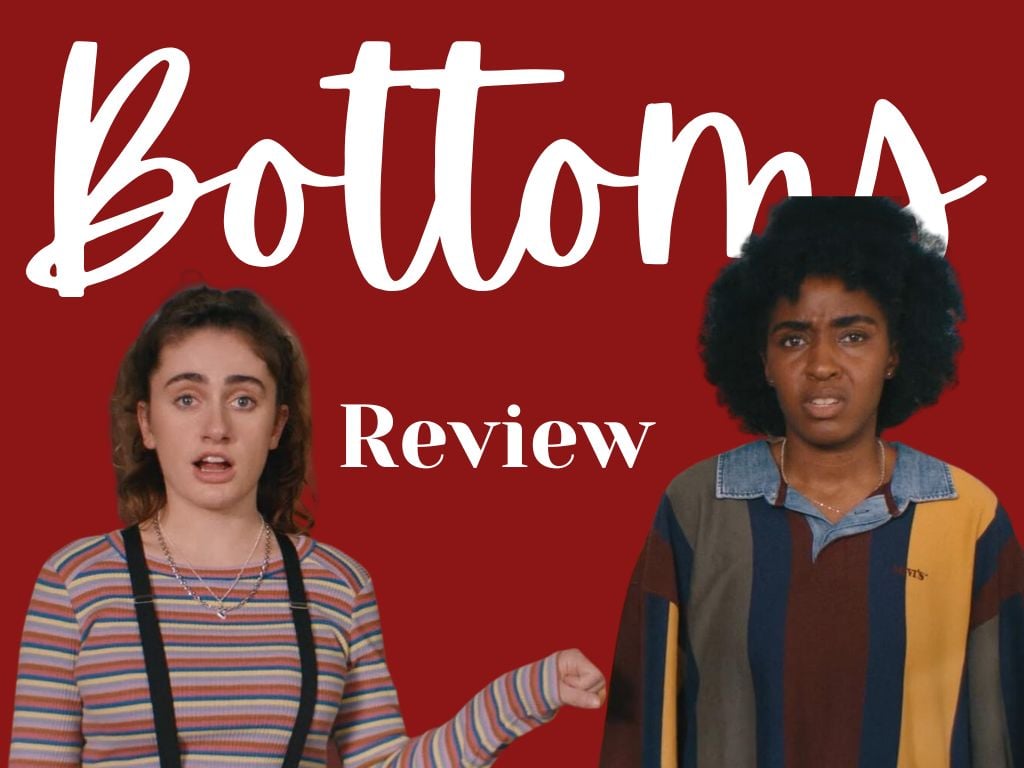Freud’s theory of psychosexual development has largely been debunked. However, if writer-director Emma Seligman’s work is any indicator, Freud was certainly right about sexuality being the realm where adults get to be playfully violent.
“Bottoms” is an exploration of the complexity of adolescent sexuality — that liminal stage where people have the will, but not always the way, to develop a sex life.
Josie (Ayo Edebiri) and PJ (Rachel Sennott, who co-wrote the script with Seligman) are entering their senior year of high school and determined to lose their virginities. They are both lesbians, and are both crushing on cheerleaders and popular girls Brittany (Kaia Jordan Gerber) and Isabel (Havana Rose Liu), respectively. PJ and Josie have long been at the bottom of the social hierarchy and thus exist firmly outside of the realm of sexuality.
As such, the heroines stretch a lie about spending the summer in juvenile hall to start a fight club. According to PJ, the main instigator, girls will come together and learn self-defense moves — but this is a cover for their real motivations. Punching and kicking one another will get hearts racing, and pain-driven adrenaline will lead to sex with the objects of their respective obsessions.
The duo insists that they are righteously randy for the right reasons, unlike the football players who rule the school and have a monopoly on dating cheerleaders. In their view, girls who desire girls are lusting in the name of feminism!
Operating under the influence of the Freudian id, PJ’s logic makes sense to her insofar as she is an adolescent girl who is too horny to think straight. Josie may be more reluctant to go along with PJ’s plan, but her high anxiety about being “off time” in terms of “normal” sexual identity development pushes her to fall in line.
Once they’ve secured a supportive faculty sponsor (Marshawn Lynch), the fight club begins to meet and Brittany and Isabel (inexplicably!) attend. A montage of the girls beating each other up gives way to a tonal shift: The girls are invited to share their sexual trauma in a somber story circle. The subject matter is heavy, but the scene is handled with great aplomb.
After weeks of fighting each other, the club members all don busted lips and black eyes. Instead of bearing invisible or carefully concealed scars, these bruises are punctuation that emphasize the vicissitudes of being a girl.
Sennott and Edebiri are pitch-perfect in their respective roles. They have the kind of humorous chemistry that makes it easy to believe they have been best friends since childhood. Liu elevates the material with line readings that give her character more depth than the popular, pretty girl archetype tends to have. At one point, she turns to Josie and says, “I really value when people use violence and raise their voices for me. It’s actually one of my love languages,” with a hilarious earnestness.
In any high school movie characterized by a rigid social hierarchy, the narrative must quickly establish why the unpopular kids are pariahs. While the socially awkward PJ and Josie bear the brunt of casual and formal homophobic bullying, they are stigmatized not only for being gay, but being gay and untalented — a meta-commentary on how gay males have gained more cultural cachet than their female counterparts.
Despite these successes, the 90-minute film drags at times and the pacing falters in the second half. The final third act inelegantly raises the stakes by altering the rules of the cinematic world, and the comedy turns very dark very quickly when the idea of a body count goes from figurative to literal.
While the heightened drama gives PJ and Josie renewed purpose for the club’s existence, it allows them to avoid confronting their entitlement to romantic entanglements with Brittany and Isabel. The plot doesn’t culminate in any introspection on their sexual desires as “out” gay girls. Instead, their hard-earned self-defense skills are used to intervene in a convoluted high school football team rivalry.
Still, many parts of “Bottoms” deserve warm praise. The sartorial choices, props and music manage to evoke the feeling that the film takes place in the nineties, aughts and today.
Although the film takes place in contemporary times, the soundtrack features music from different eras, such as Avril Lavigne’s 2002 hit “Complicated,” and “Total Eclipse of the Heart,” Bonnie Tyler’s 1983 power ballad. The latter is played on a discman during an extended montage. This temporal pastiche suggests that while this is the best time to be an openly queer teenage girl, identity constraints from the past still exist today.
Costume designer Eunice Jera Lee’s work is on point in terms of using clothing to communicate where characters fall in the pecking order. Brittany and Isabel are outfitted in more form-fitting and trendy garbs; meanwhile, PJ’s clothing is often fitted and she is rather unfashionable, as if she lost a bet and now has to spend her days in Dennis the Menace cosplay. Josie appears as if she wandered into the Glee costume archives and absconded with Finn Hudson’s whole aesthetic flow — polo for polo, khaki for khaki.
Ultimately, this layered comedy makes for a fun, unique watch, even if its narrative payoff may leave something to be desired.
Failing to conform to the rigid expectations of sexuality and gender makes adolescence feel like an impossible gauntlet. “Bottoms” seems to retort that girls can do anything that boys can. Still, perhaps the list of feminine pursuits shouldn’t include fighting to maintain a social hierarchy that subjugates them.
Maybe high school is less about starting a fight club, and more about learning how to pick your battles.
Editor’s Note: This article is a review and includes subjective thoughts, opinions and critiques.
